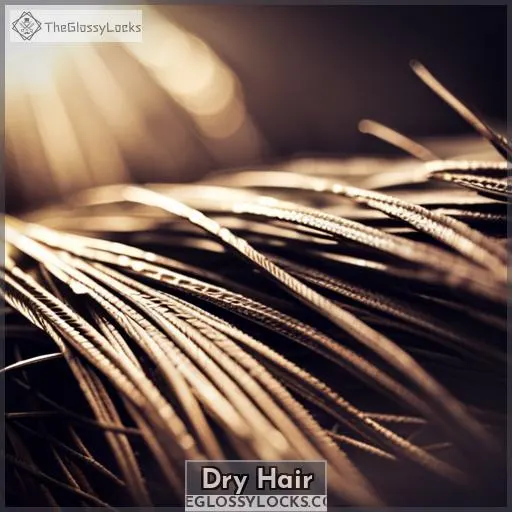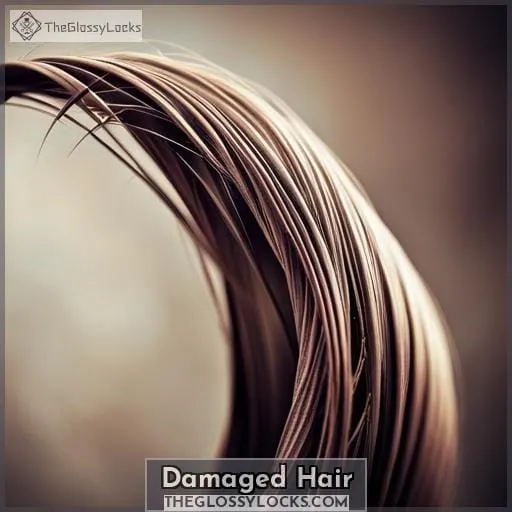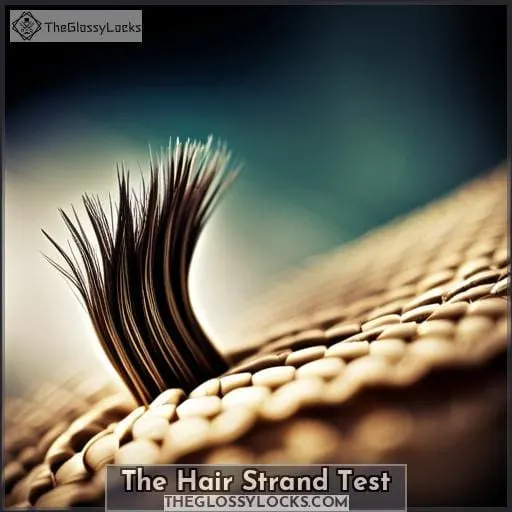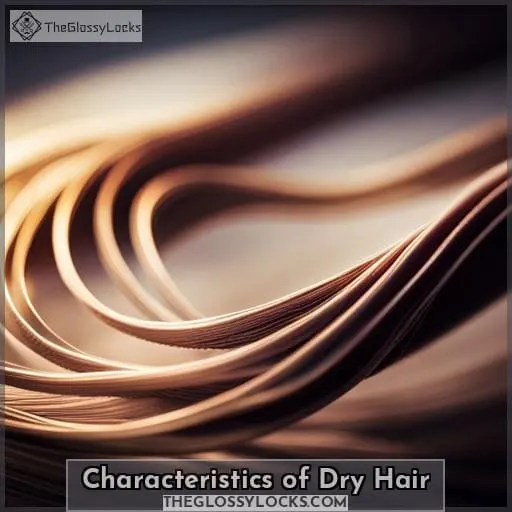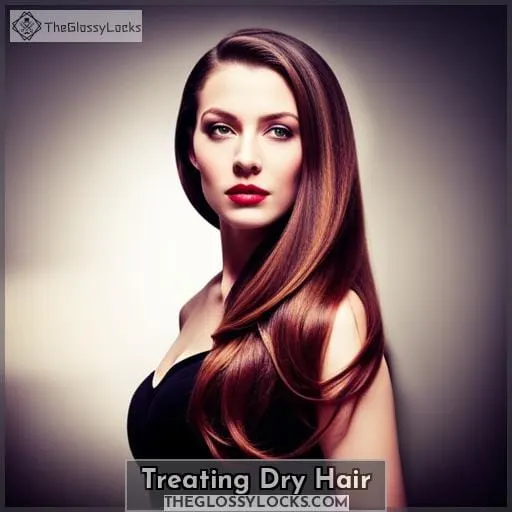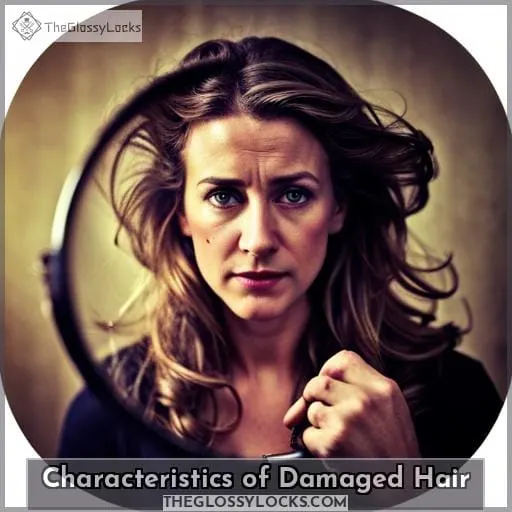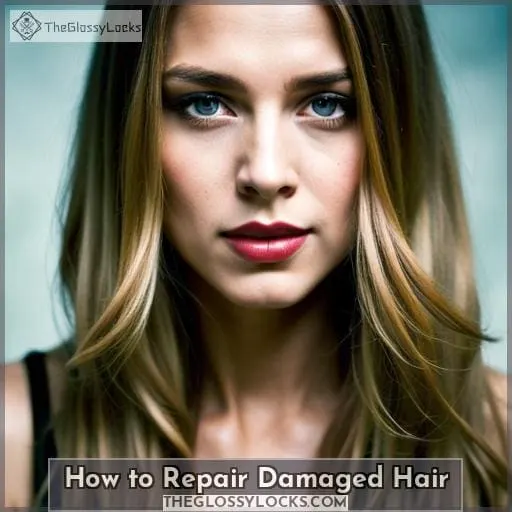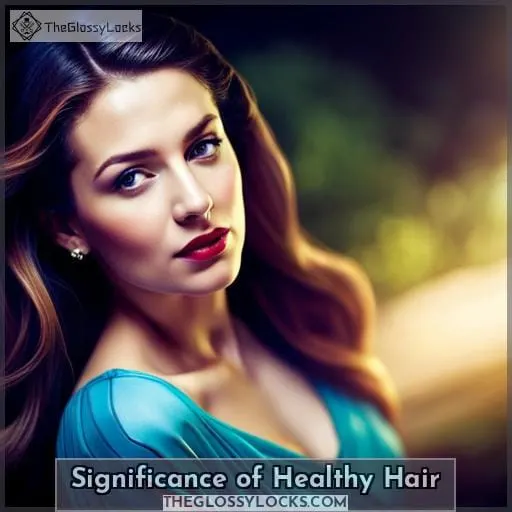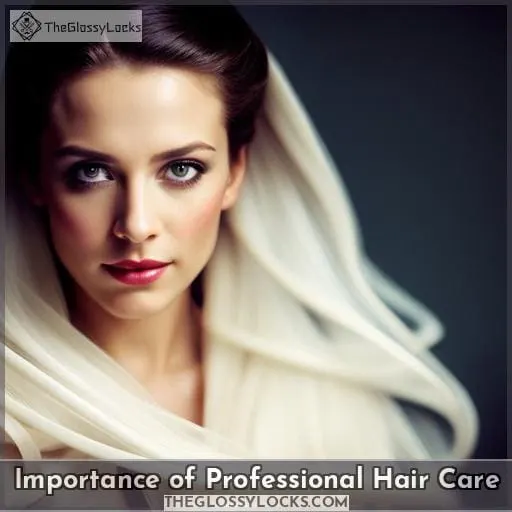This site is supported by our readers. We may earn a commission, at no cost to you, if you purchase through links.
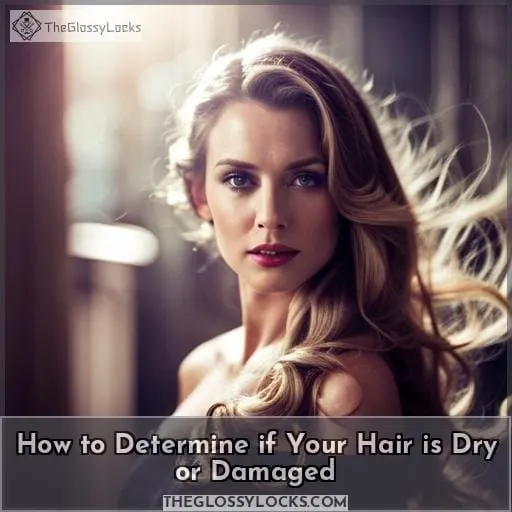 Dry hair and damaged tresses can cause a daunting dilemma – how do you tell the difference? With brittle, flat strands on one side and split ends on another, it’s easy to get confused. Fortunately, there are simple ways to distinguish between dry or damaged hair so that you can take steps towards healthier locks.
Dry hair and damaged tresses can cause a daunting dilemma – how do you tell the difference? With brittle, flat strands on one side and split ends on another, it’s easy to get confused. Fortunately, there are simple ways to distinguish between dry or damaged hair so that you can take steps towards healthier locks.
By learning how to tell if your hair is dry or damaged with a few key tests as well as understanding the signs of each type of condition, you’ll be well-equipped to take control over your mane.
Table Of Contents
Key Takeaways
- Dry hair lacks moisture, feels rough, and is frizzy.
- The lack of moisture leads to roughness and brittleness.
- A brittle and frizzy appearance is a sign of dry or damaged hair.
- Use natural ingredients like coconut oil or avocado oil for hydration.
Dry Hair
Do you have dry hair? You may notice that your hair lacks moisture, has a rough texture, and is brittle or frizzy in appearance. These are all common symptoms of dry hair that can be addressed with the right treatments and products.
Lack of Moisture
Lack of moisture can leave your hair looking and feeling rough, frizzy, dull, and brittle. To maintain a healthy balance of hydration in your hair, try incorporating moisturizing techniques such as deep-hydrating treatments with natural ingredients like coconut oil or avocado oil into your routine.
Additionally, reduce heat styling to prevent further damage from environmental effects and use protective UV products when out in the sun.
Rough Texture
You can feel the rough texture of your hair, making it difficult to run your fingers through.
To differentiate between dry and damaged hair, you need to check moisture levels as well as compare textures.
A balanced haircare routine with minimal styling options will also help maintain smooth tresses and prevent further damage.
For an improved look and feel, incorporate deep hydrating treatments into your beauty routine today—your future self will thank you for it!
Brittle and Frizzy Appearance
Your hair may appear brittle and frizzy, a sure sign of either dry or damaged locks.
- Balance moisture with hydrating products to prevent split ends and improve hair health.
- Control unruly frizz by using specially formulated anti-frizz remedies for maximum effectiveness.
- Maintain optimum scalp hydration levels to keep your strands looking healthy and smooth all day long! With the right combination of ingredients, you can restore balance in your tresses for a glossy finish that will have everyone asking what has changed!
Damaged Hair
Are you noticing split ends, breakage, or changes in texture? These can be signs of overly processed hair from chemical treatments and heat styling. Whether it’s a color job gone wrong or too many hot tools used on your locks, damaged hair is an issue that needs to be addressed immediately if you want healthy-looking tresses.
Chemical Treatments
Chemical treatments can strip away the natural oils from your hair, leading to further damage and dryness. Hair colorings, dyes, bleachings all involve harsh chemicals that may leave hair brittle and prone to breakage or split ends.
Proper care is needed for chemically processed strands with deep conditioning masks, gentle shampoos, and conditioners tailored towards chemically treated hair. Regular trims are also advised, as well as avoiding excessive heat styling tools like blow-dryers or flat irons, which can worsen already damaged tresses.
Heat Styling
Foolishly frying your follicles with heat styling can cause serious damage. Protect yourself and your hair from hot tools by using a thermal protector, but still limit their use.
Split Ends and Breakage
Ignoring those split ends and breakage at your peril – it may be the start of a slippery slope to more serious hair damage. Preventing breakage requires an effective hair care routine: 1) Regular trims, 2) Hair products designed for repair and prevention, 3) Avoiding over-styling with heat tools.
Split end solutions include mask treatments, creams, and oils tailored to nourish dry or damaged strands while sealing in moisture.
The Hair Strand Test
The hair strand test is an important tool for differentiating between healthy, dry, and damaged hair. By wetting the strands of your hair, pinching the ends together, and stretching them apart, you can observe how they return to their original shape or break.
Stretch and Observe
Gently stretch and observe your hair to differentiate between dry and damaged strands! By testing the texture of individual sections, you can assess its moisture levels.
To do this, take a strand between two fingers and pull it gently away from the scalp. Healthy hair will show good elasticity, while dry or damaged hair won’t bounce back as quickly.
Pay attention to any flaky scalps or frizz that may be present too. These are tell-tale signs of dehydration in need of hydration control products!
Keep an eye out for split ends, which often indicate damage due to excessive heat styling or chemical treatments.
With a little observation technique practice, you’ll soon get used to discerning your own unique level of hair health each day!
Differences in Healthy, Dry, and Damaged Hair
Examine the texture and appearance of your hair to differentiate between healthy, dry, and damaged strands. Healthy hair is characterized by shine, smoothness, good elasticity, and often stretches when pulled but returns to its original state.
Dry hair lacks these qualities; it usually feels rough with split ends that stretch without returning back into shape. Damaged hair may appear dull or brittle with an unhealthy texture when stretched as it may break apart easily.
Characteristics of Dry Hair
Discovering if your hair is dry or damaged can be tricky, but paying attention to a few key characteristics can help you tell the difference. Look out for signs of a dry scalp—flakiness and itchiness—as well as strands that are porous, frizzy in texture, and appear flat and lifeless.
With this information at hand, you’ll have an easier time deciding which products will best suit your needs.
Dry Scalp and Strands
Feel the texture of your scalp and strands – if they feel rough, brittle, or uneven, you may have dry hair. Take care: nourish with masks and oils to restore hydration levels; avoid chemical treatments; use a heat protectant before styling.
Scalp care is key: massage moisturizing conditioner into your scalp weekly to reduce itchiness caused by dryness.
Porous and Frizzy Texture
Run your fingers through your hair and note the texture – if it’s porous, frizzy, or brittle, it could be a sign of dryness. To combat this, use sulfate-free shampoos that won’t strip natural oils away and balance moisture levels with deep moisturizing treatments like Sap Moss from Aveda.
Nutriplenish products are also helpful for nourishing strands to help control frizz while styling.
Flat and Lifeless Appearance
If your hair is dry, it may also appear flat and lifeless due to a lack of hydration. Surprisingly, the American Academy of Dermatology states that dryness can cause more than 50% of scalp-related issues.
Boost volume with hairstyling techniques or hair care products designed to nourish and replenish moisture levels in the strands.
Try different hairstyling techniques for added body and bounce.
Use shampoos/conditioners specifically formulated for boosting moisture levels in the strands.
Create your own mask with natural ingredients such as eggs or honey mixed with superfood oils like olive oil & avocado oil.
Treating Dry Hair
It is important to properly hydrate dry hair with high-quality products, reduce the frequency of washing, and provide tender loving care. By doing so, you can ensure that your locks stay healthy and glossy in the long run.
Hydrating Hair Products
To effectively hydrate dry hair, seek nourishing products with natural ingredients like coconut oil, avocado oil, and tamarind extract. Top hair masks can help restore moisture to dull strands while moisturizing serums provide long-lasting protection from damage.
Harness the benefits of oils with leave-in treatments or DIY hydration masks made using natural moisturizers like bond builder and honey. For intensive restructuring treatment, try Aveda’s Damage Remedy range for damaged hair or Sap Moss plus Nutriplenish for deep hydration.
Reducing Washing Frequency
Cut back on cleansing and condition your locks less often to reduce washing frequency. Tamarind extract, chestnut extract, and horsetail extract will help hydrate hair naturally, while restructuring shampoo and conditioning can prevent an oily scalp caused by over-washing.
Providing Tender Loving Care
Treat yourself to some tender loving care and give your hair the hydration it needs. Develop a healthy hair care routine, incorporating hydrating treatments with natural oils like grapeseed oil or palm fruit extract.
Protect from environmental factors with UV protection and Aveda hair care products for long-term results.
Characteristics of Damaged Hair
Are you noticing split ends, breakage, or an inability to style your hair the way it used to be? It may be that your hair has been damaged due to chemical treatments and/or heat styling. Understanding the characteristics of damaged hair can help you determine if this is indeed what’s behind its current condition.
Effects of Chemical Treatments
Chemically treating your hair can lead to further damage, so consider the impact before committing to a permanent or semi-permanent change. Color effects from dyes and bleaches can weaken strands, while relaxers and straighteners strip away natural oils needed for hydration.
Chemical-free care is recommended whenever possible, but when treatments are necessary, seek out gentle formulas that won’t leave hair drier than it was before. Repairing strands requires extra attention with hydrating masks and oil treatments that replenish lost moisture without weighing down locks.
Damage From Heat Styling
Heat styling can take its toll on your tresses, so keep the blow drying and curling to a minimum.
- Preventing Heat Damage: Use low settings and limit direct contact with hair.
- Heat Styling Tips: Apply a heat protectant before styling and use clips for sectioning areas of hair when using hot tools.
- Heat Free Hairstyles: Braid, twist, or knot damp strands overnight for natural waves in the morning; try different upstyles like buns or ponytails too!
- Choosing Protectants: Look out for ingredients like silicones that coat cuticles to reduce frizziness and signs of damage from thermal tools.
- Hair Styling Alternatives: Try cold sets such as rag curls or flexi rods which give you long-lasting curl patterns without any extra heat.
Presence of Split Ends and Breakage
Split ends and breakage are key indicators that your hair is damaged, so it’s important to inspect your hair regularly. Preventing breakage starts with understanding split end remedies, such as trimming your hair regularly, using high-quality hair products, and protecting your hair from heat damage.
Another way to assess the health of your hair is by examining its elasticity. Healthy locks will stretch and then return to their normal shape, while dry or damaged hair may not recover as easily or may even break off.
To prevent split ends, it’s important to avoid using overly harsh chemicals and styling tools. Instead, try incorporating natural ingredients into your hair care routine, such as chestnut extract and palm fruit oil.
Hair breakage can be caused by excessive brushing or combing, as well as wearing tight hairstyles that strain the hair follicles.
How to Repair Damaged Hair
Managing damaged hair is essential for maintaining healthy locks. To repair damage, start by avoiding chemical treatments and limiting heat styling. Incorporate nourishing hair products into your routine to help restore shine and strength.
Avoiding Chemical Treatments
To prevent further damage, avoid chemical treatments such as dyes and relaxers. Instead, try natural styling methods. One of my clients repaired her hair by transitioning away from bleaching and using fewer heat tools.
Limiting Heat Styling
Limiting your heat styling can help prevent further damage to your hair. Protect it from hot tools with a heat protectant spray and opt for air-drying or investing in low-heat styling tools like heated rollers.
Try some alternative styles using braids, buns, twists, etc., which are safer for hair health than traditional flat ironing or curling irons.
Using Nourishing Hair Products
Nourish your hair back to health with products enriched with natural oils and extracts! Choose a conditioner suitable for your hair type; use a mask or deep-conditioning treatment once or twice per week.
Invest in styling tools that won’t damage strands, and consider scalp health when selecting shampoo. To prevent heat damage, air dry whenever possible; apply light serums as needed for extra shine. Keep healthy hair vibrant by limiting harsh chemicals, protecting it from the sun’s rays, and using gentle brushstrokes during styling sessions.
Significance of Healthy Hair
Having healthy hair is a sign of good overall health – it should be shiny, silky-smooth to the touch, and have good elasticity and flexibility. Moreover, minimal hair shedding or breakage is also an indicator that your locks are in tip-top shape.
Therefore, understanding what makes for healthy tresses can help you determine if yours is dry or damaged when necessary.
Shiny and Silky-Smooth Texture
For a shiny and silky-smooth texture, have you tried using natural ingredients like coconut oil, avocado oil, tamarind extract, or chestnut extract in your hair care routine? Glossy locks are achievable with regular use of these products.
Good Elasticity and Flexibility
Touch your hair and observe: healthy hair should have good elasticity and flexibility, bouncing back to its original shape after stretching. To improve elasticity, hydrate with custom masks plus ingredients like coconut oil or avocado oil.
Hair strength can be increased by avoiding chemicals and heat styling; use products containing chestnut extract for protection.
Minimal Hair Shedding and Breakage
To maintain healthy hair, reducing breakage and shedding is essential. Incorporating nutrient-rich diets and regular hair care routines can help prevent excessive shedding. Common causes of increased hair loss include stress, hormonal imbalances, scalp infections, and certain medications.
Minimizing heat styling and avoiding harsh chemicals are key to minimizing breakage, while using quality products with natural ingredients helps lock in moisture for optimal results.
Importance of Professional Hair Care
Taking proper care of your hair is essential for maintaining overall health and appearance. Booking regular appointments with a professional hairstylist, using recommended products, and seeking advice if excessive shedding occurs are key to ensuring healthy hair.
By doing so, you can ensure that your locks remain strong and vibrant for years to come.
Booking Regular Hair Appointments
Booking regular hair appointments with a professional stylist is key to keeping your locks looking and feeling healthy. Professional care can help determine the best haircut for your face shape, provide product recommendations tailored just for you, and create customized styling techniques to maintain hair health in between salon visits.
Salon visits should occur every six weeks so that split ends are kept at bay and dead ends don’t build up; this prevents further damage while promoting growth. A good stylist will also be able to tell if your hair is dry or damaged, allowing them to tailor treatments accordingly.
Investing in quality professional haircare ensures strong, vibrant locks!
Using Recommended Hair Products
You’ll need the right products to keep your hair looking and feeling its best: custom masks, leave-in treatments, and natural oils for dry strands. Some recommended ingredients for damaged hair are chestnut extract, horsetail extract, grapeseed oil, or palm fruit extract.
It is advisable to have regular haircuts with Aveda stylists every 6 weeks. Additionally, it is important to practice natural drying and use UV protection. Avoiding chemicals and heat styling is also recommended, while incorporating deep-hydrating treatments into your routine.
Healthy habits, such as maintaining a balanced diet, also play an important role in keeping hair healthy. Environmental factors, such as sun exposure or frequent washing, can lead to damage if not monitored properly.
Seeking Professional Advice for Excessive Hair Shedding
If you notice excessive hair shedding, it’s wise to seek professional advice. Poor diet, genetics, and stress can cause scalp issues that lead to more severe forms of hair loss. Remedies for excessive shedding include lifestyle changes like reducing stress levels or taking vitamin supplements for better scalp health.
Conclusion
Having healthy hair is essential to feeling confident and beautiful. Knowing how to distinguish between dry and damaged hair is key to finding the right products and treatments to keep your hair looking great.
The hair strand test is a great way to tell the difference. Dry hair will stretch but won’t return to its original state, while damaged hair will stretch and may break.
To hydrate dry hair, use custom masks and leave-in treatments. To repair damaged hair, avoid chemicals and heat styling and use products containing chestnut extract, horsetail extract, grapeseed oil, and palm fruit extract.
Regular haircuts with an Aveda stylist and natural drying and UV protection can also help prevent damage. With the right care and attention, you’ll be able to keep your hair looking and feeling great.

